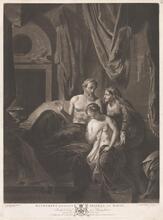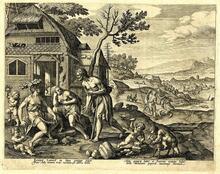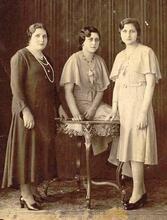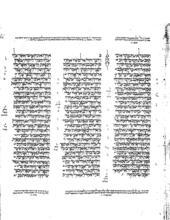Berenice
Berenice was the daughter of King Agrippa I, the grandson of Herod the Great and client king of Judea. She married her uncle Herod, King of Chalcis, a small realm in Syria. After his death, Chalcis was awarded to her brother, with whom she ruled for a time until she married King Polemo of Cicilia, Anatolia. She returned to Judea in time for the outbreak of the Great Jewish Revolt in 66 CE. Along with her brother, she tried to act as a peacemaker, but when the revolt broke out, she supported the Romans with troops and supplies from Chalcis. In 68, Berenice became the lover of the Roman general (and future Emperor) Titus, who destroyed Jerusalem two years later. She returned with him to Rome, after which she faded from the historical record.
Berenice, daughter of King Agrippa I, queen of Chalcis, was married three times and then became the lover of the emperor’s son, Titus. Inscriptions indicate that she was a Roman citizen and bore the Roman name Julia. Our information on her comes initially from Josephus, but it appears that because of personal considerations he withheld vital information about Berenice, which we learn only from various Roman historians.
The Jewish Queen
Berenice was probably born in Rome to Agrippa and Cyprus, before her father became king in 36 C.E. Thus she was Herod the Great’s great-granddaughter. After her father’s ascension to the throne, as the Emperor Caligula’s favorite, she was betrothed to Marcus, son of Alexander, head of the Jewish community in Alexandria and nephew of Philo the philosopher. According to calculations, she was only thirteen at the time (Josephus, Ant. 19.276–277). It is unclear whether or not she actually married Marcus. After his death in 44 C.E., when she was sixteen years of age, her father arranged a marriage for her with his older brother, Herod. The Emperor Claudius, who had confirmed Agrippa’s kingship in Judea, also nominated his brother Herod as king of Chalcis, a tiny principality in the Lebanon Mountains. With her marriage to Herod, she became queen of Chalcis, a title she retained after her husband’s death, as inscriptions and literary sources indicate. Berenice had two sons by Herod—Hyrcanus and Berenicianus—of whom we know nothing. She was widowed for a second time in 48 C.E., when only twenty (Ant. 19.277, 20.104).
After Herod’s death, the Romans bestowed the kingdom of Chalcis on Berenice’s older brother, Agrippa II. Agrippa’s move into residence in his new kingdom brought brother and sister into close quarters. Many sources indicate that they were often found together in official capacities. Inscriptions mention them together (with Berenice noticed first). Josephus informs us that they appeared in public together, for example when Agrippa gave his peace address to the people of Jerusalem just before the outbreak of revolt against Rome (Josephus, BJ 2.333; 402–405). He also describes Philip son of Jacimus writing a letter addressing the two royal siblings (Josephus, Vita 48; 180). The New Testament mentions Berenice’s presence with her brother at the Apostle Paul’s trial (Acts 25:13). Even in rabbinic literature she is mentioned as the queen alongside her brother, the king (BT A seven-day festival to commemorate the Exodus from Egypt (eight days outside Israel) beginning on the 15th day of the Hebrew month of Nissan. Also called the "Festival of Mazzot"; the "Festival of Spring"; Pesah.Pesahim 57a). In two sources this constant companionship is interpreted as incest. One source is the Roman satirist Juvenal, who mentions their relationship in passing as a well-known fact (Juvenal, Saturae 6.155–158). The other is Josephus, who claims that rumors of the siblings’ inappropriate relationship led Berenice to seek a third match (Ant. 20.145–146).
As a spouse, Berenice chose Polemo, King of Cilicia. This match led Polemo to undertake circumcision and a Jewish lifestyle. These concessions on his part, however, did not guarantee a successful marriage. Sometime later Berenice left Polemo and returned to her kingdom. Thus she was present in Palestine when the 66–70 C.E. Revolt against Rome broke out.
The Jewish Revolt
Josephus describes Berenice’s role as a solitary pacifying force in preliminaries of the Revolt. He explains her presence in Jerusalem as resulting from a vow she had made, which she needed to fulfill. As required by the vow, her hair was shorn and she walked barefoot. Nevertheless, she made her way to the Roman governor’s palace to ask Gessius Florus—the Roman governor—to desist from the violent activities he had undertaken against the Jewish population of Jerusalem (BJ 2.313). This attempt failed. So did her joint venture with her brother, who had meanwhile arrived in Jerusalem, to still the Jewish insurrection, which came in the wake of Florus’s outrages (BJ 2.402–405).
After this failure Berenice disappears from the pages of Josephus. Probably his special relationship with Titus prevented him from describing the relationship that developed between Berenice and his patron. Even his unflattering description of Berenice’s incestuous relationship with her brother appears only in his later work, Jewish Antiquities, composed after Titus died.
It is from Tacitus that we learn that with the outbreak of war Berenice chose to side with the Romans and supplied General Vespasian’s offensive with local forces (Histories 2.81.2). Tacitus is also our first source on Berenice’s love affair with Titus (Histories 2.2.1), the Roman general who eventually burnt Jerusalem and then succeeded his father to the throne of Rome. The two apparently became lovers in 68 C.E. Berenice was considerably older than Titus. However, Tacitus is not the only source that discloses this information. Seutonius and Cassius Dio relate similar details. In 75 C.E., they inform us, Berenice came to Rome and lived with Titus as his consort. However, public pressure made the emperor’s son relinquish his ties with the queen and she was sent away. Vaguely, we hear that when Titus himself became emperor in 79 Berenice returned to Rome but to no avail and she was compelled to leave (Suetonius, Titus 7.1; Cassius Dio, Roman History 66.15.3–4). Nothing more is known of her.
Braud, D. C. “Berenice in Rome.” Historia
33 (1984): 12–13.
In this note Braud suggests that Titus dismissed Berenice only after
he became emperor in 79 C.E.,
and that she returned to Rome before his death in 81, and not because of his
promise when he first dismissed her.
Crook, John A. “Titus and Berenice.” American
Journal of Philology 72 (1951): 162–175.
In this article Crook suggests that all Titus’ actions regarding Berenice
were politically motivated, since they belonged to one party which had supported
the Flavian claim to the throne, and opposed another such party, headed by
Mucianus.
Ilan, Tal. Integrating
Jewish Women into Second Temple History. Tübingen: 1999.
pp. 92–96: “Things Unbecoming a Woman” (Ant.
13:431) Josephus and Nicolaus on Women
pp. 217–233: Julia Crispina, A Herodian Princess in the Babatha Archive.
Two chapters in this book discuss certain aspects of Berenice’s life. In her
chapter on women in the writings of Josephus, Ilan shows how Josephus’ rhetorical
interests influence his description of the Queen. In her chapter on Julia
Crispina, mentioned in the Babatha archive, Ilan suggests that the woman was
Berenice’s granddaughter.
Jordan, Ruth. Berenice.
London: 1974.
Jordan is a journalist. In an enchanting book of documentary fiction Jordan
outlines Berenice’s life with all its complexities and identity crises.
Krieger, Klaus-Stefan. “Berenike—Die Schwester König Aggripas II., bei Flavius
Josephus.” JSJ
28 (1997): 1–11.
This article discusses the very different representations of this woman found
in Josephus’ BJ
(positive) and Ant.
(negative). He explains her positive portrait as a result of her connections
with Titus, his patron, and her negative portrayal as emanating from her support
of Justus of Tiberias, Josephus’ enemy.
Levick, Barbara. “Titus and the Jewish Princess.” Wolfson
College, Oxford: College Record (1999–2000): 60–73.
In this entertaining paper, Levick discusses and attempt by the foremost modern
historian of Rome, Ronald Syme, to reconstruct Tacitus’ lost chapter on the
affair of Titus and Berenice.
Macurdy, Grace H. Vassal
Queens and Some Contemporary Women in the Roman Empire, 84–90. Baltimore:
1937.
Macurdy was and remains the foremost historian on Helenistic and Roman royal
women. In this chapter Macurdy places Berenice within the Hellenisitc-Roman
setting of gender-power relationships. It is also an excellent survey of all
the sources (literary and epigraphic) that mention Berenice.
Mireaux, Emile.
La Riene Bérénice.
Paris: 1951.
This is the most complete attempt to write a biography for Berenice. Its most
original contribution is to suggest that the Book of Judith was written in
order to urge Berenice to do to Titus what Judith had done to Holophernes.
Rogers, Perry M. “Titus, Berenice and Mucianus.” Historia
29 (1980): 86–95.
This article is an answer to Crook’s historical reconstruction, claiming that
it was not politics that led to Berenice’s dismissal but commonsense on the
part of the future emperor, who needed popular support.
Schwartz, D. R. “κατά τούτον τόν καιρόν: Josephus’ Source on Agrippa II.”
JQR
72 (1981–2): 241–268.
In this article Schwartz explores the sources on Agrippa II used by Josephus,
and suggests that the texts denigrating Berenice that he uses in Ant.
derive from a pious Jewish source and do not reflect Josephus own opinions.
Berenice was also immortalized in various plays and novels, e.g. Howard Fast, Agrippa’s Daughter. New York: 1964; Leon Kolb, Berenice: Princess of Judea. New York: 1959, and see further in Jordan, ibid.














